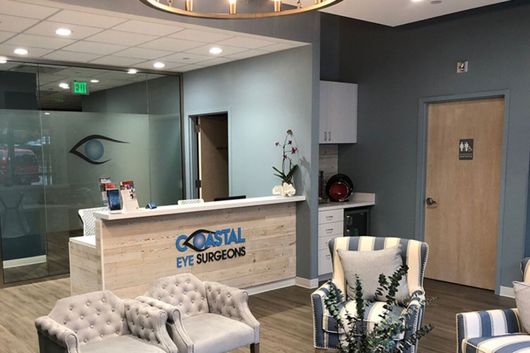
The cornea is the clear, dome-shaped surface in front of the eye. It has two main responsibilities -- focus light into the back of the eye and protect your eyes from bacteria, germs, and dust via tears. In fact, your corneas are responsible for nearly 70% of the eye’s total focusing power.
There are five major layers of the cornea -- the endothelium, Descemet’s membrane, stroma, Bowman’s layer, and the epithelium. Experiencing issues with any of these layers could have a negative impact on your ability to see. That’s why the health of your cornea is so important.
While there are so many things that can go wrong with the cornea, a corneal transplant surgery can help restore vision and overall function of the cornea. Now, don’t worry if you’re asking yourself, “What is a cornea transplant?” -- we’re going to explain everything you need to know!
So, What Is A Cornea Transplant?
A cornea transplant, better known as a keratoplasty in the medical community, is a type of surgery that replaces a damaged or diseased cornea with healthy human donor tissue. When done correctly, it can successfully restore vision in the eye and improve cornea appearance.
The donor cornea comes from a healthy organ donor that has passed away. Due to the high number of donor corneal tissue available, there is no wait for this type of surgery. In fact, this type of eye surgery carries a very high success rate with the technology available today.
In some cases, the body’s immune system might accidentally start attacking the healthy donor tissue. This is known as rejection, but it doesn’t mean you’re out of luck. Your eye surgeon will either try again with tissue from a new cornea or move forward with an artificial cornea instead.
Signs You Might Need a Corneal Transplant
Cornea transplants are considered one of the most successful tissue transplants in their entire human body. That’s why an eye surgeon will almost always recommend this type of transplant when they detect any issue with the cornea -- especially if it’s causing vision loss or impairment.
Here are some of the most common signs you might need a corneal transplant:
- Fuch’s dystrophy
- Bulging of the cornea
- Corneal ulcers (chronic)
- Tearing or thinning of the cornea
- Scarring or swelling of the cornea
- Sensitivity to light
- Complications from another eye surgery
If you’re experiencing any of these symptoms, you should schedule a comprehensive eye exam with your eye doctor immediately. They have the equipment and knowledge needed to detect, diagnose, and treat the problem -- especially in the case of a cornea transplant.
Different Types of Cornea Transplant Surgery
Before an specialized cornea eye surgeon can repair your diseased or damaged cornea, they must first determine what type of cornea transplant surgery you need. There are a variety of different corneal transplants to choose from, all depending on what corneal layer is damaged or diseased.
Partial Thickness vs. Full Thickness Corneal Transplant
The type of transplant will be broken down into two general categories -- a partial thickness cornea transplant or full-thickness cornea transplant. Partial thickness involves replacing only part of the cornea, while full-thickness involves replacing the entire cornea with healthy tissue.
Let’s take a look at some of the most common types of partial thickness and full-thickness corneal transplants:
Penetrating Keratoplasty (PK)
This is a type of full-thickness corneal surgery where the eye surgeon uses a trephine or femtosecond laser to make an incision through the entire cornea. Once the damaged tissue is replaced with new corneal tissue, they use stitches to hold the cornea in place while it heals.
Artificial Cornea Transplant (Keratoprosthesis)
This is another type of full-thickness cornea transplant that is generally reserved for those that experience cornea rejection. It generally involves replacing the damaged cornea with a Boston Type I Keratoprosthesis, one of the most common artificial corneas used in practice today.
Anterior Lamellar Keratoplasty (ALK)
This is a type of partial thickness cornea transplant that involves replacing the front layers of the cornea -- the epithelium and the stroma -- while keeping the back layers in place. There are two main types of ALK surgery -- deep anterior and superficial anterior -- which we’ll discuss below.
Superficial Anterior Lamellar Keratoplasty (SALK)
With a superficial anterior lamellar keratoplasty, also known as SALK, only the front most layer of the cornea is replaced. This includes the epithelium layer, but not the stroma. The dissection depth is less than one-third or 160 µm and is eventually replaced with healthy donor tissue.
Deep Anterior Lamellar Keratoplasty (DALK)
A deep anterior lamellar keratoplasty, also known as DALK, is a surgical procedure that replaces the epithelium layer and the supporting stroma with healthy tissue. Unlike the SALK technique, the DALK surgery involves a dissection depth greater than one-third or 160 µm.
Endothelial Keratoplasty (EK)
An endothelial keratoplasty, also known as EK, is the opposite of an ALK surgery. Since the endothelial is the innermost layer of the cornea, it involves replacing the back layers of the cornea, while keeping the front layers in place. There are two main types -- DSEK and DMEK.
Descemet Membrane Endothelial Keratoplasty (DMEK)
The descemet membrane endothelial keratoplasty, also known as DMEK, involves replacing a very thin disc of corneal tissue with donor tissue. This generally includes just the endothelium layer and Descemet’s membrane, but not the supporting stroma.
Descemet Stripping Endothelial Keratoplasty (DSEK)
Unlike with a DMEK, a descemet stripping endothelial keratoplasty -- also known as DSEK -- involves replacing a larger disk of corneal tissue. This generally includes the supporting stroma, as well as the endothelium and descemet’s membrane.
Contact Your Local Eye Doctor Today!
Now that we’ve answered the burning question of the hour -- “What is a cornea transplant?” -- you should have a firm understanding of what it is, why they’re performed, the signs and symptoms your doctor is on the lookout for, and the different types of transplants used today.
Coastal Eye Surgeons
Whether you think you’re suffering from a damaged cornea or simply want to learn more about your personal eye health, contact Coastal Eye Surgeons today and schedule an eye exam with Dr. Omar Shakir.
He can help improve your vision and put you on the right path to see clearly!
Be sure to also read more information on What Is the First Sign of Glaucoma.






